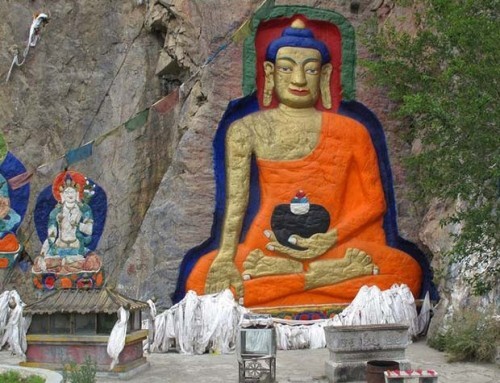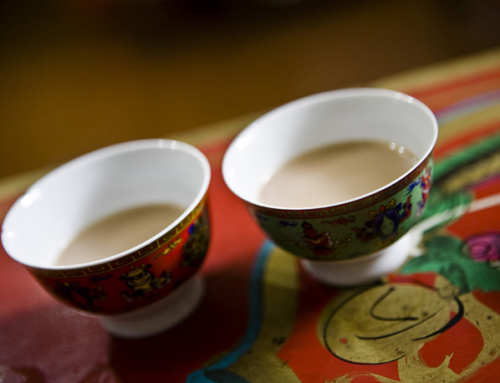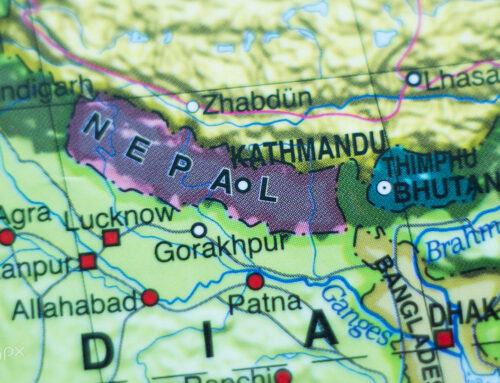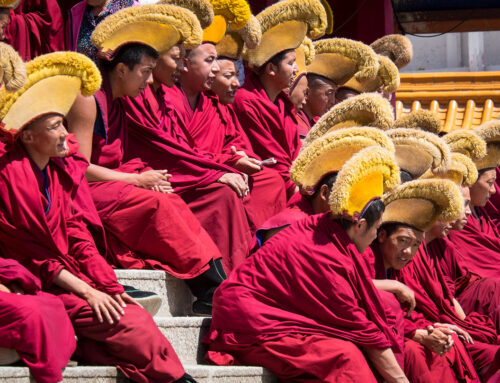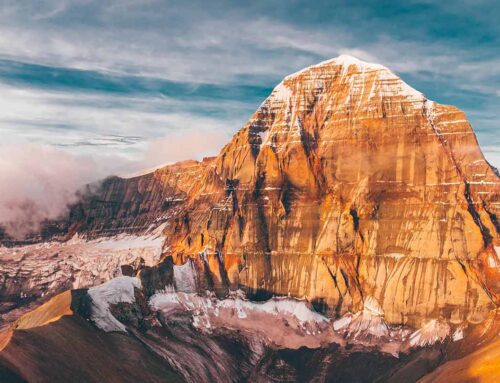Top 10 Must-Visit Places in Tibet. Tibet, often referred to as the “Roof of the World,” is a land of mystique, spirituality, and natural grandeur. Nestled in the heart of the Himalayas, Tibet is a destination like no other.
This article takes you on a journey through the top 10 must-visit places in Tibet, each offering a unique experience and a deep connection to Tibetan culture and nature.
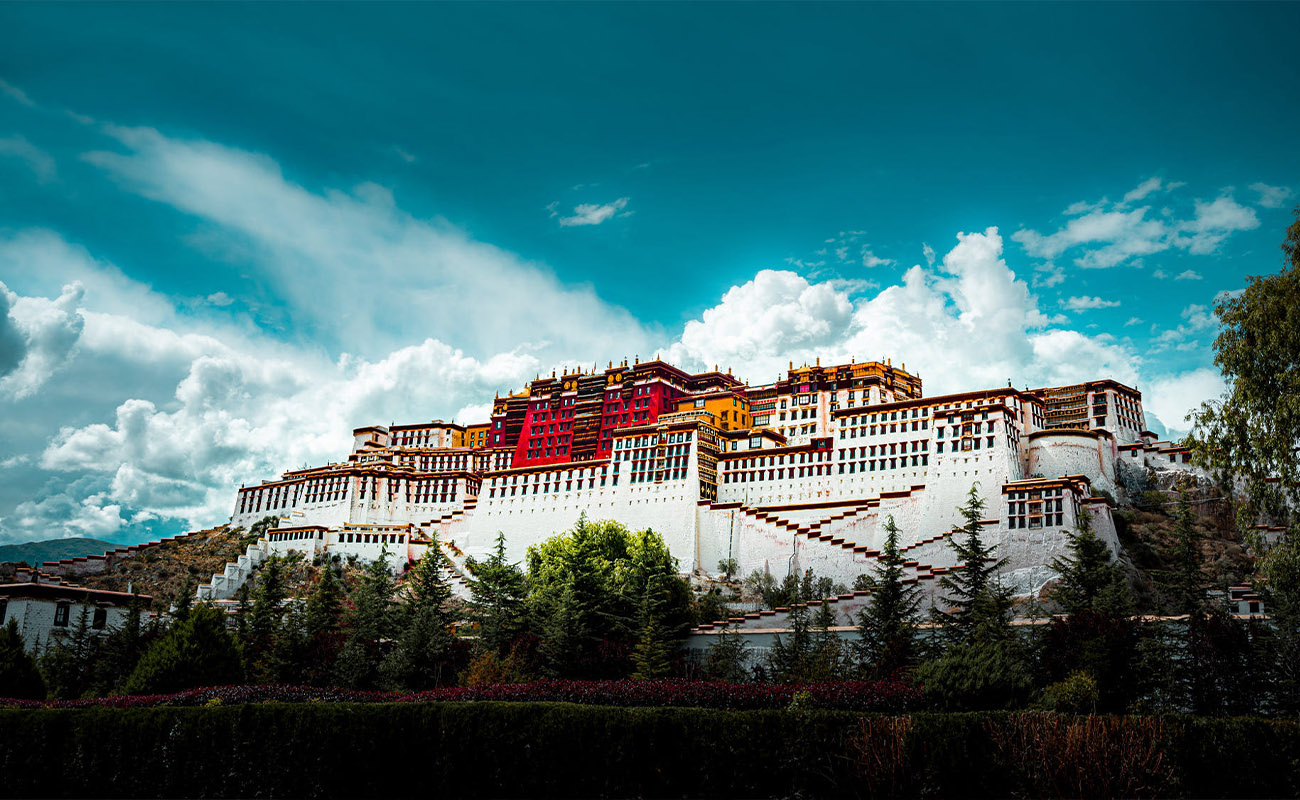
Lhasa – The Roof of the World
Lhasa, often referred to as the “Roof of the World,” stands as the beating heart of Tibet, exuding an enchanting blend of tradition and modernity. This iconic city is where the soul of Tibetan culture finds expression against the backdrop of a rapidly changing world. Here’s a more extensive exploration of what makes Lhasa a must-visit destination:
A Cultural Oasis
Lhasa is not just a city; it’s a cultural oasis. Its ancient streets are infused with a rich tapestry of traditions that date back centuries. As you stroll through its bustling markets and narrow alleyways, you’ll encounter friendly locals who are eager to share their heritage. The city’s cultural diversity is evident in its architecture, art, and way of life.
The Majestic Potala Palace
Dominating the Lhasa skyline, the Potala Palace is a UNESCO World Heritage Site and the crowning jewel of Tibetan architecture. Its towering, whitewashed walls and golden roofs house a treasure trove of Tibetan art, religious relics, and history. A visit to the Potala Palace offers a profound glimpse into Tibet’s past and its spiritual essence.
Jokhang Temple – A Pilgrimage of Faith
The Jokhang Temple, nestled in the heart of Lhasa, is a revered pilgrimage site for Buddhists from all corners of the world. Its spiritual significance is underscored by the Jowo Rinpoche, a revered statue of the young Buddha, which is enshrined here. The temple’s Barkhor Square is always abuzz with pilgrims, turning it into a dynamic hub of devotion and cultural exchange.
Barkhor Street – The Soul of Lhasa
Barkhor Street, encircling the Jokhang Temple, is a hub of activity and a testament to the city’s vibrant culture. This lively street is lined with market stalls selling everything from traditional Tibetan clothing and handicrafts to exquisite thangka paintings. As you walk the kora (circuit) around the Jokhang Temple, you’ll join pilgrims spinning prayer wheels and immerse yourself in the profound spirituality of Tibet.
Traditional Tibetan Cuisine
No visit to Lhasa is complete without savoring the delectable flavors of traditional Tibetan cuisine. Sample dishes like momo (dumplings), thukpa (noodle soup), and yak butter tea, experiencing the essence of Tibetan flavors. Lhasa’s teahouses and local eateries offer an authentic culinary journey.
A Window to Modern Tibet
While preserving its traditions, Lhasa has also embraced modernity. You’ll find a fusion of ancient and contemporary in the city, with modern shops, hotels, and restaurants coexisting alongside historic monasteries and temples. This unique blend allows travelers to experience both sides of Tibet – the ancient and the evolving.
In summary, Lhasa is the gateway to Tibet’s rich cultural heritage and spirituality. Its harmonious coexistence of tradition and modernity, the grandeur of the Potala Palace, the spiritual significance of the Jokhang Temple, and the vibrant Barkhor Street make it an indispensable destination for any traveler seeking an authentic Tibetan experience. Explore the past and present of this remarkable city as you embark on your journey to the “Roof of the World.”
Mount Everest Base Camp
– A Dreamlike Adventure
For those who yearn for adventure that touches the very edge of the sky, the Mount Everest Base Camp is a dream come true. Nestled at a breathtaking altitude of 5,200 meters (17,060 feet), this iconic destination offers an experience that transcends the boundaries of ordinary exploration. Let’s delve deeper into this extraordinary journey to the world’s highest peak:
The Pinnacle of Adventure
The journey to Mount Everest Base Camp is a quest of extraordinary magnitude. It is the closest most of us will ever come to standing at the pinnacle of the world, where the Earth seems to touch the heavens. The challenge of reaching this remote destination, coupled with the sheer height and awe-inspiring beauty of the Himalayas, makes it a bucket-list experience for adventure seekers.
A Landscape Beyond Imagination
The Everest Base Camp doesn’t just promise adventure; it delivers an otherworldly landscape that defies imagination. As you trek through the Khumbu region, you’ll find yourself surrounded by towering peaks, deep valleys, and vast glaciers. The vistas are an ever-changing canvas of ice and rock, a testament to the raw power of nature.
The Enigmatic Khumbu Icefall
One of the most iconic and treacherous sections of the climb is the Khumbu Icefall. This labyrinth of towering ice seracs and crevasses presents a formidable challenge to climbers. As you traverse this frozen maze, you’ll gain a profound appreciation for the courage and tenacity of those attempting to conquer Everest’s summit.
A Glimpse into Climbing History
The Everest Base Camp is not only a place for climbers; it’s also a living museum of mountaineering history. Tents from various expeditions dot the landscape, and you may encounter climbers from around the world preparing for their ascent. The stories of triumphs and tragedies that echo through the thin mountain air are a testament to human determination and the indomitable spirit of exploration.
The Journey of a Life time
Reaching Mount Everest Base Camp is not just about the destination; it’s about the journey itself. The trek is a physically demanding yet spiritually rewarding experience. It’s a path that tests your endurance, exposes you to breathtaking beauty, and invites you to reflect on the magnitude of the natural world.
In conclusion, the Mount Everest Base Camp is more than just a destination; it’s a gateway to adventure, a tribute to human exploration, and a humbling experience in the face of nature’s grandeur. Whether you’re a seasoned mountaineer or an aspiring adventurer, this dreamlike journey to the top of the world offers an unforgettable encounter with the Earth’s highest peak.
Namtso Lake
– A Serene Sanctuary Amidst the Himalayas
Namtso Lake, situated at an awe-inspiring altitude and renowned as one of the world’s highest saltwater lakes, is more than a geographic wonder – it’s a profound sanctuary of serenity and spirituality. This body of crystal-clear turquoise waters, fringed by majestic snow-capped peaks, offers a unique experience that transcends the ordinary, with a captivating ecosystem that includes wild yaks and migratory birds. Let’s embark on an extensive exploration of this hidden gem:
A Natural Wonder of High Altitude
Namtso Lake is no ordinary body of water. At an elevation of 4,718 meters (15,479 feet) above sea level, it’s one of the highest lakes on Earth. Surrounded by the lofty peaks of the Nyenchen Tanglha Mountain Range, the lake’s remote location and remarkable elevation contribute to its unique character.
The Sacred Lake
Namtso, which means “Heavenly Lake” in Tibetan, holds profound spiritual significance for the Tibetan people. It is believed to be a sacred lake, and the pristine waters are said to possess purifying qualities. Pilgrims and travelers alike are drawn to its shores to seek spiritual solace and connect with the divine.
An Oasis of Tranquility
One of the most striking aspects of Namtso is its overwhelming sense of tranquility. As you gaze across the vast expanse of clear, placid waters and breathe in the crisp Himalayan air, you’ll find yourself enveloped in an aura of peace. The lake’s calm surface mirrors the surrounding mountains, creating an ethereal reflection that transports you to a realm of serenity.
The Unique Ecosystem
Namtso Lake isn’t just about breathtaking scenery; it’s also a vital ecosystem. The lake and its surrounding wetlands are home to diverse flora and fauna, including unique Tibetan wildlife. Here, you can encounter herds of wild yaks grazing peacefully along the shores and observe the dance of migratory birds overhead. The lake is a habitat that celebrates life in the harshest of conditions.
The Nomadic Way of Life
The region around Namtso is inhabited by Tibetan nomads, and their traditional way of life is intimately connected to the land. Visiting the lake offers an opportunity to interact with these warm-hearted nomadic families and gain insight into their culture. You can witness their traditional yak-wool tents and savor authentic Tibetan dishes while listening to tales of their generations-old existence.
A Stargazer’s Paradise
Namtso Lake is not only a sanctuary by day but also a stargazer’s paradise by night. The high-altitude location and minimal light pollution make it an ideal spot for stargazing. On a clear night, you can revel in the brilliance of a thousand stars, making it a surreal experience under the vast Tibetan sky.
In summary, Namtso Lake is a destination that defies description and leaves an indelible mark on all who visit. It’s a place where the boundaries between the earthly and the divine blur, where serenity and spirituality merge, and where the wonders of nature unfold in an ecosystem unique to this high-altitude haven. Namtso Lake invites you to immerse yourself in its purity, connect with its profound spirituality, and witness the Himalayas’ pristine beauty in all its glory.
The Yarlung Tsangpo Grand Canyon – Nature’s Marvel of the Tibetan Plateau
Often hailed as the “Grand Canyon of the East,” the Yarlung Tsangpo Grand Canyon is a natural wonder that beckons adventurers and nature enthusiasts from around the world. This awe-inspiring chasm, sometimes compared to the Grand Canyon in the United States, is a masterpiece of nature that will leave you utterly spellbound. Whether you choose to navigate its mighty river by raft or conquer its rugged terrains on a hiking expedition, the Yarlung Tsangpo Grand Canyon promises an unforgettable and extensive adventure:
A Geological Spectacle
The Yarlung Tsangpo Grand Canyon is a geological spectacle that took millions of years to craft. Carved into the Tibetan Plateau by the relentless flow of the Yarlung Tsangpo River, this canyon reaches depths of up to 5,382 meters (17,658 feet), surpassing even the Grand Canyon in the United States. The sheer scale and complexity of its formation make it a sight to behold and a testament to the power of nature.
A Journey into the Abyss
The Yarlung Tsangpo Grand Canyon is a geological spectacle that took millions of years to craft. Carved into the Tibetan Plateau by the relentless flow of the Yarlung Tsangpo River, this canyon reaches depths of up to 5,382 meters (17,658 feet), surpassing even the Grand Canyon in the United States. The sheer scale and complexity of its formation make it a sight to behold and a testament to the power of nature.
Rafting the Mighty Yarlung Tsangpo
Rafting down the Yarlung Tsangpo River is an adventure like no other. The river’s course through the canyon is a wild ride, filled with thrilling rapids, serene stretches, and cascading waterfalls. As you navigate its waters, you’ll be surrounded by towering cliffs, lush forests, and a sense of remoteness that transports you to an untouched world.
A Diverse Ecosystem
The Yarlung Tsangpo Grand Canyon is not just a visual marvel; it’s also a thriving ecosystem. Its diverse flora and fauna include endangered species like the snow leopard, red panda, and black-necked crane. The surrounding forests are a sanctuary for unique plant species, and the canyon’s pristine waters are home to various aquatic life forms.
Rich Tibetan Culture
Exploring the Yarlung Tsangpo Grand Canyon is not just about its natural wonders. It’s also an opportunity to connect with the local Tibetan culture. The communities living near the canyon are known for their warm hospitality and unique way of life. Visiting their villages and monasteries is a chance to immerse yourself in the richness of Tibetan traditions.
A Quest of Discovery
Venturing into the Yarlung Tsangpo Grand Canyon is a quest of discovery and self-reflection. The challenges of the journey and the captivating beauty of the landscape invite introspection and a deep appreciation for the wild, untamed side of nature. It’s a place where you can escape the noise of the modern world and find solace in the embrace of pristine wilderness.
In summary, the Yarlung Tsangpo Grand Canyon is a natural masterpiece that invites adventurers to explore its rugged terrain, raft its mighty river, and bask in the beauty of an ecosystem teeming with life. It’s a place where you can marvel at the geological forces that shaped the Earth, immerse yourself in the local Tibetan culture, and embark on a journey that will transform your perspective of the world. The Grand Canyon of the East promises an extensive adventure like no other, a journey into the heart of Earth’s raw, unadulterated beauty.
Shigatse
– The Vibrant Tapestry of Tibet’s Second-Largest City
Shigatse, Tibet’s second-largest city, is a vibrant and bustling hub that reveals a different facet of Tibetan culture. As you traverse through its lively streets, you’ll discover a city that harmoniously blends tradition and modernity, where the grandeur of the Tashilhunpo Monastery, the seat of the Panchen Lama, stands tall amidst the energetic local life. Exploring Shigatse isn’t just about visiting monastic marvels; it’s a chance to immerse yourself in the tapestry of local culture, connect with the welcoming residents, and savor the authenticity that the city exudes. Let’s embark on an extensive journey into the heart of Shigatse:
The centerpiece of Shigatse is the Tashilhunpo Monastery, one of the most significant monastic complexes in Tibet. This grand monastery is not just a place of worship; it’s an architectural marvel adorned with golden roofs and intricate artwork. It serves as the traditional seat of the Panchen Lama, the second-highest spiritual authority in Tibetan Buddhism after the Dalai Lama. Inside, you’ll find ancient scriptures, religious relics, and a towering statue of the Maitreya Buddha. The spiritual ambiance and historical significance of Tashilhunpo Monastery make it a must-visit for those seeking to delve into Tibetan Buddhism and its cultural heritage.
Exploring the Monastery Complex
Tashilhunpo Monastery is not just a single building; it’s a complex of chapels, prayer halls, and living quarters. As you wander through its labyrinthine corridors, you’ll encounter monks in deep meditation, hear the soft chants of prayers, and admire exquisite murals that depict stories from Tibetan Buddhism. The Kelsang Temple within the complex, dedicated to the protector deity Palden Lhamo, is a place of special reverence.
The Buzz of Local Markets
Shigatse’s markets are a treasure trove of local culture. Stroll through the lively bazaars, where you can shop for traditional Tibetan handicrafts, including colorful thangka paintings, handwoven textiles, and exquisite jewelry. The markets are also a place to indulge your taste buds in local delicacies, from momo dumplings to yak butter tea.
Local Experiences and Cultural Immersion
Shigatse offers a genuine opportunity for cultural immersion. The city’s vibrant streets are teeming with friendly locals eager to share their traditions and stories. Engage with residents, participate in local ceremonies, and gain insight into the daily lives of Tibetans. Home visits and interactions with nomadic families provide a unique glimpse into the nomadic way of life, a significant part of Tibetan culture.
The Majestic Shigatse Dzong
Shigatse Dzong, also known as the Samdruptse Dzong, is another notable landmark. Perched on a hill overlooking the city, this fortress-like structure offers panoramic views of Shigatse and the surrounding countryside. The Dzong’s strategic location and historical significance make it a place of interest for history enthusiasts and photographers.
A City of Vibrant Festivals
Shigatse is known for its vibrant festivals and celebrations, where the city comes alive with traditional music, dance, and colorful processions. The Tibetan New Year, Saga Dawa, and other local festivals provide an excellent opportunity to witness the exuberance of Tibetan culture.
In summary, Shigatse is more than just a city; it’s a cultural crossroads where spirituality and modernity converge. It’s a place to delve into the grandeur of the Tashilhunpo Monastery, explore bustling markets, engage with welcoming locals, and partake in the vibrant festivals that define Tibetan life. Shigatse offers an extensive and authentic experience that captures the essence of Tibet’s rich cultural heritage, making it a destination of significance for every traveler.
Mount Kailash
– The Spiritual Epicenter of Multiple Faiths
Mount Kailash, a sublime and sacred peak standing tall amidst the Trans-Himalayan region, holds immense spiritual significance that transcends the boundaries of religion. This revered mountain is considered holy by multiple faiths, including Buddhism, Hinduism, and Jainism. Embarking on the spiritual journey to trek around the sacred mountain, known as the Kora, is not just a physical endeavor; it’s a profound journey of devotion, self-discovery, and deep spiritual connection. Let’s embark on an extensive exploration of this unique and revered destination:
A Spiritual Crossroads
Mount Kailash is often referred to as the “center of the world.” This majestic peak is the confluence of several of the world’s major religions, making it a sacred site of great importance. For Hindus, it is the abode of Lord Shiva; for Buddhists, it is the dwelling place of Demchok; and for Jains, it is associated with their first Tirthankara, Rishabhadeva. This convergence of spiritual traditions adds a layer of mystique to the mountain, making it an epicenter of spirituality.
The Kora – A Journey of Devotion
One of the most revered pilgrimages in the world, the Kora around Mount Kailash is a journey of devotion and reflection. This ritual circumambulation is considered an act of profound faith and spiritual purification. Pilgrims from around the world embark on this trek to seek blessings, absolution, and a deeper connection with the divine.
The Spiritual Significance
As you walk the Kora, you’ll encounter numerous monasteries, chortens (stupas), and prayer flags that line the route. These are not just physical markers; they are symbols of faith, hope, and spiritual progress. The sound of chanting and prayer wheels spinning creates an atmosphere of profound devotion, further underscoring the sacred nature of this journey.
A Challenging Endeavor
Trekking around Mount Kailash is not just a physical challenge; it’s also a test of endurance and determination. The trail is situated at a high altitude, with unpredictable weather conditions, rocky terrain, and steep ascents. Yet, pilgrims and trekkers undertake this arduous journey with unwavering devotion, a testament to the power of faith.
The Inner Journey
While the physical trek around Mount Kailash is undoubtedly demanding, it is also an inner journey of self-discovery. The solitude and silence of the Tibetan plateau provide an opportunity for introspection, meditation, and self-realization. Many who complete the Kora find it a transformative experience, deepening their understanding of themselves and their place in the world.
The Beauty of the Landscape
Beyond its spiritual significance, Mount Kailash is set in one of the most breathtaking landscapes on Earth. The surrounding valleys, pristine lakes, and snow-capped peaks create a backdrop of unparalleled beauty. The clear blue skies and crisp mountain air offer a visual and sensory feast to those who undertake this pilgrimage.
In summary, Mount Kailash is not just a mountain; it is a place of profound spiritual significance that transcends religious boundaries. It’s a destination where the journey itself becomes a transformative experience, and the act of circumambulating the sacred peak is a testament to the enduring power of faith. Set against the backdrop of the awe-inspiring Trans-Himalayan landscape, Mount Kailash is a destination where devotion, self-discovery, and the divine meet in an extensive journey of the spirit.
Yamdrok Lake
– A Sapphire Jewel Amidst the Himalayan Splendor
Yamdrok Lake, a mesmerizing alpine gem that graces the Tibetan plateau, is a natural wonder that evokes awe and reverence. Its deep blue waters mirror the cerulean skies above and are surrounded by the majestic embrace of snow-capped mountains. The journey to this ethereal lake is not just a drive; it’s an expedition that presents some of the most breathtaking views in Tibet. Make sure to have your camera ready, for this journey is one of unparalleled beauty and serenity. Let’s embark on an extensive exploration of Yamdrok Lake:
The Pristine Waters
Yamdrok Lake, often referred to as “Yamzho Yumco,” is characterized by its serene, deep blue waters. The lake’s name, which means “turquoise lake” in Tibetan, perfectly describes its tranquil and mesmerizing hue. The clarity and purity of these waters reflect the unspoiled beauty of the Tibetan Plateau.
A Gift from Nature
The creation of Yamdrok Lake is a geological marvel. It is one of the three largest sacred lakes in Tibet and is believed to be a gift from nature itself. The lake is formed from the melting waters of glaciers that flow from the surrounding mountains. It is this unique origin that lends Yamdrok Lake its distinctive color and crystal-clear depths.
An Alpine Oasis
Surrounded by a dramatic amphitheater of snow-capped peaks, Yamdrok Lake is an alpine oasis that invites tranquility and reflection. The encircling mountains, which include the famous Nojin Kangsang, serve as guardians of the lake, their towering presence enhancing the majesty of the water below.
The Drive of a Lifetime
The journey to Yamdrok Lake is an adventure in itself. The drive takes you through twisting mountain roads, revealing sweeping vistas of the Himalayas. As you ascend, you’ll witness the landscape change from lush valleys to barren plateaus, each turn offering a new perspective and a photograph-worthy moment.
A Sacred Site
Yamdrok Lake is not just a natural wonder; it is also a sacred site for Tibetans. The lake is believed to be the dwelling place of the protective deity Dorje Gegkyi Tso, and it holds a significant place in Tibetan Buddhism. Many pilgrims circumambulate the lake, offering prayers and seeking blessings from its pristine waters.
A Photographer’s Paradise
The breathtaking beauty of Yamdrok Lake makes it a photographer’s paradise. Every angle offers a stunning composition, from the contrast of the azure lake against the rugged mountains to the play of light and shadow on the water’s surface. The changing weather and the reflections on the lake only add to its photographic allure.
An Ecosystem in Harmony
Yamdrok Lake is not just a sight to behold; it’s also an ecosystem teeming with life. The surrounding wetlands and grasslands support a variety of plant and animal species, including migratory birds and Tibetan wildlife. The lake is a vital component of the fragile Tibetan plateau ecosystem.
In summary, Yamdrok Lake is more than just a body of water; it’s a natural masterpiece, a gift from nature, and a site of spiritual significance. The journey to the lake is an expedition through Himalayan splendor, and the lake itself is a reflection of Tibet’s untouched beauty. It invites contemplation, photography, and a deep appreciation for the natural wonders of our planet. Yamdrok Lake is an extensive experience of serenity, awe, and the pristine grandeur of the Tibetan plateau.
Tsetang
– The Cradle of Tibetan Civilization
Tsetang, often referred to as the “cradle of Tibetan civilization,” is a place that breathes history at every turn. Nestled in the heart of the Yarlung Valley, this ancient town offers a journey back in time where the foundations of Tibetan culture were laid. As you explore Tsetang, you’ll encounter the iconic Samye Monastery, Tibet’s first Buddhist monastery, and the Yumbulakang Palace, where Tibetan history comes to life. Let’s embark on an extensive exploration of Tsetang:
A Historical Tapestry
Tsetang is a living testament to Tibet’s historical legacy. It’s a town where the stories of emperors, scholars, and spiritual seekers have woven a rich tapestry of culture and tradition. The Yarlung Valley, where Tsetang is located, is often referred to as the “Valley of the Kings” due to its historical significance.
Samye Monastery
– The Birthplace of Tibetan Buddhism
One of the most notable landmarks in Tsetang is the Samye Monastery, revered as the birthplace of Tibetan Buddhism. Constructed in the 8th century, it’s not just a religious site; it’s a living heritage of Tibetan spirituality. The architectural design, which represents the universe in a mandala, is a visual marvel. The monastery’s richly decorated interiors, sacred murals, and prayer halls reflect the profound spirituality that has shaped Tibet for centuries.
Yumbulakang Palace
– A Living Chronicle
The Yumbulakang Palace is a place where Tibetan history takes on a tangible form. It is believed to be the first building in Tibet and the legendary palace of Tibet’s first king, Nyatri Tsenpo. The architecture, with its white walls and wooden balconies, provides a glimpse into ancient Tibetan construction techniques. The views from the palace, which overlook the Yarlung Valley, are stunning.
The Valley of Kings
The Yarlung Valley is often referred to as the “Valley of Kings” due to its historical treasures. It’s home to various ancient burial mounds, including the burial site of King Songtsen Gampo, one of Tibet’s most iconic rulers. The valley offers an opportunity to connect with the history of Tibet’s royalty and to imagine life in the times of these remarkable monarchs.
The Cradle of Tibetan Culture
Tsetang is not just a destination for history enthusiasts; it’s also a place to immerse yourself in Tibetan culture. The town’s traditional architecture, local festivals, and friendly residents provide a chance to experience the essence of Tibetan life. The weekly market is a hub of activity where you can shop for local handicrafts, fresh produce, and interact with the warm-hearted locals.
A Place of Pilgrimage
Tsetang is often a starting point for pilgrims embarking on spiritual journeys to Samye Monastery and beyond. The town’s spiritual ambiance and the presence of numerous monasteries make it a place of reverence and pilgrimage for Buddhists and travelers seeking spiritual enlightenment.
In summary, Tsetang is more than just a town; it’s a living chapter of Tibetan history, a spiritual sanctuary, and a cultural treasure. It is where the roots of Tibetan civilization run deep, and where the stories of emperors and spiritual seekers continue to echo through time. Exploring Tsetang allows you to immerse yourself in the essence of Tibetan culture, spirituality, and history. It is an extensive experience that invites you to step into the heart of Tibet’s past and present.
Shannan Region
– Unveiling Tibet’s Authentic Cultural Treasure
The Shannan Region, often hidden from the tourist’s eye, is a concealed gem within the heart of Tibet. Unlike some of the more frequented tourist destinations, Shannan offers an opportunity to experience the rich tapestry of Tibetan culture and traditions in an authentic and unadulterated manner. From the vibrant Tibetan New Year celebrations to the colorful local festivals, Shannan has a treasure trove of experiences to share with those who venture off the beaten path. Let’s embark on an extensive exploration of the Shannan Region:
A Cultural Mosaic
Shannan is a cultural mosaic where the threads of Tibetan heritage and traditions are interwoven. It is a place where the authenticity of Tibetan culture is preserved, celebrated, and lived. From the traditional dress to the daily rituals, Shannan is a living testament to Tibet’s rich cultural identity.
The Tibetan New Year
The Tibetan New Year, known as Losar, is a grand celebration in Shannan. The region comes alive with vibrant processions, music, and dance. Monasteries are adorned with prayer flags, and families gather to offer prayers and exchange greetings. Losar is a time when the spirit of renewal, hope, and cultural heritage takes center stage.
Ancient Monasteries
Shannan is home to several ancient monasteries, each with its own unique history and significance. These monastic complexes are not just religious sites; they are living repositories of Tibetan Buddhist philosophy, art, and culture. They provide insight into the spiritual aspect of Tibetan life and offer a serene ambiance for meditation and reflection.
The Authentic Tibetan Lifestyle
Shannan offers a glimpse into the daily lives of Tibetan people. It’s a place where nomadic traditions, such as yak herding and traditional crafts, continue to thrive. Visiting local homes, enjoying traditional Tibetan dishes, and witnessing yak festivals are experiences that provide a window into the authentic Tibetan way of life.
Local Festivals
Shannan hosts a variety of local festivals, from horse racing festivals to harvest celebrations. These events are an opportunity to witness the exuberance of Tibetan culture, complete with colorful costumes, traditional dances, and engaging competitions. Participating in or simply observing these festivals is an immersive experience that creates lasting memories.
The Unspoiled Beauty of Nature
Shannan is not just a cultural haven; it is also a place of natural beauty. The region is surrounded by pristine landscapes, including lush valleys, sparkling rivers, and snow-capped mountains. The tranquility and untouched beauty of the natural environment provide a perfect backdrop to the cultural experiences that await.
In summary, the Shannan Region is a cultural treasure waiting to be unveiled by intrepid travelers. It offers an extensive immersion into the authentic tapestry of Tibetan culture, from Losar celebrations to ancient monasteries, nomadic traditions to local festivals. Shannan is where the soul of Tibet beats most vibrantly, where the rich heritage of the region is passed down through generations, and where travelers can connect with a culture deeply rooted in tradition and spirituality. It’s a place that offers not just a journey but a genuine encounter with Tibet’s living traditions and enduring spirit.
Conclusion – Embracing Tibet’s Timeless Allure
Tibet, a land of mystique and wonder, unfurls before the traveler like a tapestry of unparalleled beauty and spiritual richness. Each corner of this extraordinary destination offers an experience that transcends the ordinary. Whether you seek spiritual enlightenment, thrilling adventures in the Himalayas, or a deep dive into an ancient and rich culture, Tibet has it all. The allure of this remarkable land is an invitation to embark on a journey that promises to be transformative, inspiring, and unforgettable. It’s an experience that every traveler should endeavor to embrace at least once in their lifetime.
A Land of Spirituality
Tibet is a realm where spirituality permeates every facet of life. From the awe-inspiring monasteries to the sacred peaks and tranquil lakes, spirituality is a cornerstone of Tibetan existence. The deep-rooted faith and profound rituals are an invitation for travelers to explore their inner selves and connect with something greater than the self.
Adventures in the Himalayas
For the adventurous souls, Tibet offers unparalleled opportunities to conquer the mighty Himalayas. From the challenging trek to Mount Everest Base Camp to the spiritual journey of the Kora around Mount Kailash, the Himalayas become both a playground and a path of self-discovery. The rugged terrains and pristine landscapes provide a canvas for outdoor enthusiasts to explore, conquer, and be humbled by the power of nature.
Cultural Immersion
Tibet’s culture is a treasure trove of ancient traditions, art, and a way of life that defies time. Whether it’s the grandeur of monasteries in Tsetang, the living heritage in Shannan, or the bustling markets in Shigatse, cultural immersion in Tibet is a journey through the ages. Engaging with the locals, participating in festivals, and savoring the local cuisine are experiences that create lasting memories.
Unspoiled Beauty
Tibet is synonymous with untouched natural beauty. The landscape is a symphony of pristine lakes, soaring peaks, and unspoiled wilderness. The clear skies and crisp mountain air create a visual and sensory delight. Each corner, whether it’s the sapphire waters of Yamdrok Lake or the grandeur of the Yarlung Tsangpo Grand Canyon, showcases nature at its finest.
In conclusion, Tibet is not just a destination; it’s a profound experience that touches the heart, stirs the soul, and leaves an indelible mark on the traveler. It’s a place where ancient spirituality meets the grandeur of nature and the warmth of a vibrant culture. The allure of Tibet is an invitation to explore, to be inspired, and to be transformed. It’s a destination every traveler should aspire to experience at least once in their lifetime.
FAQs
Is it safe to travel to Tibet?
Tibet, a land of profound beauty and spirituality, offers a unique and enchanting travel experience. While it is generally safe for tourists, there are essential considerations to keep in mind, particularly regarding the high altitude. Safety is paramount, and adequate preparation is key to ensuring a secure journey through this remarkable destination.
Understanding Altitude Concerns
The most prominent safety concern for travelers in Tibet is the high altitude. Lhasa, Tibet’s capital, is situated at an altitude of approximately 3,656 meters (11,990 feet), and many other destinations in the region are even higher. Altitude sickness, also known as acute mountain sickness (AMS), can affect individuals when they ascend to higher elevations too rapidly. Symptoms can range from mild discomfort to severe illness, so it’s crucial to be aware of the potential risks and take precautions.
Preparing for Altitude
Before embarking on your journey to Tibet, it’s advisable to consult a healthcare professional to discuss altitude-related concerns. They can provide guidance on managing altitude sickness, as well as prescribe medications if necessary. Additionally, it’s beneficial to acclimatize to the high altitude gradually. Spend your first few days in Lhasa or another lower-altitude location to allow your body to adjust to the reduced oxygen levels.
Hydration and Diet
Staying well-hydrated is essential to combat altitude sickness. Drink plenty of water throughout your journey, and avoid alcohol and excessive caffeine consumption, as these can contribute to dehydration. A diet rich in carbohydrates can also aid in acclimatization. Local foods such as Tibetan barley bread and yak butter tea are staples that can help maintain energy levels.
Local Regulations and Permits
To ensure a safe and hassle-free journey, it’s important to be aware of local regulations and permit requirements. Travelers to Tibet are typically required to obtain a Tibet Travel Permit, which is usually arranged through a registered tour agency. Familiarize yourself with these regulations, and ensure you have all the necessary permits to explore the region.
Respect Local Customs and Traditions
Respecting the local customs and traditions is not just a matter of cultural sensitivity; it can also contribute to your safety. Tibetan Buddhism plays a significant role in daily life, and it’s essential to be mindful of religious sites and practices. Dress modestly when visiting monasteries, and always ask for permission before taking photographs, as some locations may be sensitive to photography.
Communication and Emergency Contacts
Before your journey, make sure you have a reliable means of communication. While mobile phone coverage is available in most urban areas, it may be limited in more remote regions. Keep a list of emergency contacts, including the contact information for your embassy or consulate, local authorities, and your tour agency.
In conclusion, traveling to Tibet can be a safe and enriching experience when you prepare adequately and are mindful of the high altitude. By taking the necessary precautions, respecting local customs, and being aware of altitude-related concerns, you can ensure a secure and memorable journey through this captivating land of spirituality and natural beauty.
Do I need a special permit to visit Tibet?
Exploring the mystical realms of Tibet is a dream for many travelers, and while it’s a destination of extraordinary allure, it comes with specific permit requirements. To embark on this enchanting journey, you’ll need a Tibet Travel Permit, and this permit is typically arranged through a registered tour agency. Here, we delve into the details of these permits and the process of obtaining them.
Tibet Travel Permit
The Tibet Travel Permit is a prerequisite for travelers wishing to visit Tibet, regardless of whether you plan to explore the capital city, Lhasa, or venture into more remote regions. This permit is a vital document, and it’s designed to ensure that travelers comply with regulations and experience Tibet through guided tours to help preserve the unique culture and environment.
The Role of Tour Agencies
To obtain a Tibet Travel Permit, travelers must work through a registered tour agency. This agency will facilitate the application process on your behalf. It’s essential to select a reputable and experienced tour agency to ensure a smooth and secure journey. They will assist with the paperwork, plan your itinerary, and provide a knowledgeable guide for your trip.
The Application Process
Here’s a step-by-step overview of the typical permit application process:
1. Choose a Tour Agency: Research and select a tour agency with experience in organizing trips to Tibet.
2. Plan Your Itinerary: Work with the agency to plan your trip, including the places you wish to visit and the duration of your stay.
3. Provide Required Documents: You will need to submit scanned copies of your passport and Chinese visa to the tour agency. They will use these documents to apply for your Tibet Travel Permit.
4. Permit Application: The tour agency will submit your permit application to the Tibet Tourism Bureau (TTB) in Lhasa. This process may take several weeks, so it’s advisable to plan your trip well in advance.
5. Permit Issuance: Once your permit is approved, it will be issued in Lhasa. Your tour agency will obtain the permit and send it to your starting destination in mainland China or provide it to you upon your arrival in Lhasa.
Restrictions and Group Travel
Travelers holding Tibet Travel Permits are typically required to be part of a group tour. Individual travel to many areas of Tibet is restricted, and having a guide with you during your journey is a standard practice to ensure safety and adherence to regulations. However, in Lhasa and some other urban areas, travelers may have a degree of flexibility to explore independently.
Respect Regulations and Local Customs
While traveling in Tibet, it’s crucial to respect local regulations and customs. This includes not straying from your approved itinerary and refraining from political discussions or activities. Additionally, always carry your Tibet Travel Permit with you, as it may be checked at various points during your journey.
In conclusion, obtaining a Tibet Travel Permit is a necessary step for those seeking to explore this captivating land. Working with a registered tour agency is the most reliable way to secure this permit and enjoy a secure and enriching journey. By understanding the process and respecting local regulations, you can experience the beauty and spirituality of Tibet while preserving its unique culture and environment.
What’s the best time to visit Tibet?
Selecting the ideal time to visit Tibet is pivotal in ensuring an enjoyable and rewarding travel experience. While Tibet possesses its unique charm throughout the year, there are specific seasons when the weather and conditions align most favorably for outdoor activities and exploration. Spring and autumn are considered the best times to venture into this captivating land, offering a perfect blend of pleasant weather, cultural events, and breathtaking landscapes.
Springtime in Tibet
March to May
Spring heralds the awakening of Tibet after the long and serene winter. This is a time when the landscape comes to life with vibrant blossoms, and the clear blue skies offer stunning views of the Himalayas. Here are the highlights of visiting Tibet during spring:
Blooming Beauty
Tibet’s landscapes burst into a riot of color during spring. The vast plains and rolling hills are adorned with wildflowers, and the fruit trees are in full bloom. The sight of pink and white peach blossoms, as well as rhododendrons, is a visual treat.
Comfortable Weather
Spring brings comfortable temperatures, making it an ideal time for outdoor activities and exploration. The days are pleasantly warm, and the nights are cool but not freezing, creating the perfect environment for sightseeing, trekking, and other adventures.
Cultural Festivals
Tibetan New Year, Losar, typically falls in February or March. The festive celebrations, which continue into early spring, are a fascinating cultural experience. You can witness traditional dances, visit monasteries, and join in the exuberant festivities.
Autumn Splendor in Tibet
September to November
Autumn ushers in a tapestry of golden hues as Tibet’s landscapes prepare for winter’s arrival. The clear skies and crisp air create an atmosphere of serenity and make autumn another excellent choice for a visit. Here’s why you should consider autumn for your Tibet adventure:
Foliage and Harvest
The fall season in Tibet is marked by the changing colors of the foliage. The landscape is painted in shades of gold and red as the trees prepare to shed their leaves. It’s also the time of harvest, and you can witness farmers working in the fields, bringing in their crops.
Perfect Weather
Autumn offers some of the most pleasant weather conditions in Tibet. The days are still warm, while the evenings and nights are cooler but not uncomfortably cold. This creates an ideal climate for outdoor activities and sightseeing.
Clear Views
The crisp autumn air provides exceptional visibility, making it an excellent time for photography and enjoying unobstructed views of Tibet’s stunning landscapes. The mountain peaks, including Mount Everest, are often at their most visible during this season.
Fewer Tourists
Compared to the peak summer months, autumn sees fewer tourists. This means less crowded attractions and a more peaceful and relaxed atmosphere for your journey.
In conclusion, the best time to visit Tibet is during spring and autumn. These seasons offer a harmonious blend of comfortable weather, natural beauty, and cultural experiences. Whether you prefer the vibrant blossoms and cultural celebrations of spring or the golden landscapes and clear skies of autumn, Tibet welcomes you with its unique charm and timeless allure.
Are there any restrictions on photography in Tibet?
Photography is a powerful means to capture the ethereal beauty and spiritual depth of Tibet. The vast landscapes, ancient monasteries, and the vibrant cultural tapestry offer an abundance of photographic opportunities. However, it’s important to be mindful of local customs and regulations, especially at religious sites, where restrictions on photography may apply.
Photography at Religious Sites
In Tibet, many religious sites, including monasteries and temples, hold deep spiritual significance for the local community. While photography is generally allowed in these places, there are certain etiquettes and restrictions to keep in mind:
1. Always Ask for Permission: Before taking photographs at a religious site, it’s advisable to ask for permission. Some monasteries or specific areas within them may have restrictions on photography. Monks or guides can guide you on where and when it’s appropriate to take pictures.
2. Respect Religious Practices: During religious ceremonies, prayers, or rituals, it’s crucial to refrain from taking photographs. Disturbing or interrupting these practices with the click of a camera can be considered disrespectful.
3. Dress Modestly: When visiting religious sites, dress modestly and respectfully. Revealing clothing may be considered offensive, and it’s essential to follow local customs. Additionally, remove your hat and sunglasses as a sign of respect.
4. No Flash Photography: Avoid using a flash when taking pictures inside religious buildings. The sudden burst of light can disrupt the solemn atmosphere and disturb worshippers.
Landscape Photography in Tibet
Tibet’s breathtaking landscapes are a photographer’s dream. From the pristine lakes to the soaring peaks, the opportunities for capturing the natural beauty are endless. Here are some considerations for landscape photography:
1. Environmental Awareness: While photographing Tibet’s natural wonders, it’s important to be an environmentally responsible photographer. Do not disturb the local flora and fauna, and carry out all your trash.
2. Weather and Light: Tibet’s weather can be unpredictable, so be prepared for changing conditions. The quality of light can vary, and different times of the day offer different moods for your photographs.
3. Altitude Challenges: The high altitude in Tibet can be challenging for photographers. It’s important to acclimatize gradually and take frequent breaks to avoid altitude sickness. Be prepared for the physical demands of high-altitude photography.
4. Respect for Locals: When photographing local people, always ask for their consent. Not everyone may be comfortable with having their picture taken. Show respect for the local culture and traditions.
Permits and Regulations
When traveling in Tibet, you’ll need to ensure you have the necessary permits, including the Tibet Travel Permit. This permit is essential for foreign tourists and is typically arranged through a registered tour agency. Make sure to carry a copy of your permit with you, as it may be checked at various checkpoints.
In conclusion, photography is a wonderful way to capture the essence of Tibet, but it should be done with respect for local customs and regulations. When visiting religious sites, always ask for permission and be mindful of the sanctity of the place. In the vast and enchanting landscapes of Tibet, be an environmentally responsible photographer and respect the local communities you encounter. With the right approach, you can capture the unparalleled beauty and spirituality of Tibet while showing due respect for its people and culture.
How can I acclimatize to the high altitude in Tibet?
Tibet, with its lofty plateaus and towering peaks, boasts some of the highest altitudes on Earth. Travelers are often drawn to this mystical land to explore its beauty and spirituality, but it’s essential to acclimatize gradually to the high altitude to ensure a comfortable and safe journey. Here are some valuable tips on how to adapt to the high altitude of Tibet.
1. Take It Slow:
Upon your arrival in Tibet, especially in Lhasa, which is situated at a considerable altitude of about 3,656 meters (11,990 feet), it’s crucial to take it easy during the first few days. Avoid strenuous activities and allow your body to adjust to the reduced oxygen levels. This period of rest will help minimize the risk of altitude sickness, also known as acute mountain sickness (AMS).
2. Stay Hydrated:
Staying well-hydrated is of paramount importance in high-altitude regions. The dry air and reduced oxygen levels can lead to increased water loss through respiration and perspiration. Drinking plenty of fluids, particularly water, can help combat dehydration and its associated symptoms.
3. Avoid Alcohol and Excessive Caffeine:
While enjoying the local cuisine and beverages is part of the travel experience, it’s advisable to limit alcohol and excessive caffeine intake, as they can contribute to dehydration and exacerbate the effects of high altitude. Opt for herbal teas or warm water instead.
4. Eat Carbohydrate-Rich Foods:
A diet rich in carbohydrates can help with acclimatization. Foods such as Tibetan barley bread and tsampa, a roasted barley flour, are dietary staples that provide sustained energy and can aid in adapting to the high altitude.
5. Medication and Consultation:
Before your journey, consider consulting a healthcare professional, especially if you have a history of altitude sickness or underlying medical conditions. They can provide guidance on medications, such as acetazolamide, which may be prescribed to prevent or alleviate AMS symptoms.
6. Portable Oxygen:
Some travelers opt to carry portable oxygen canisters, which can provide relief in case of mild altitude sickness symptoms. These canisters are available in Tibet and are commonly used by locals and tourists.
7. Natural Remedies:
Locals often use natural remedies to alleviate altitude sickness symptoms. Ginger tea, garlic soup, and yak butter tea are believed to be helpful. You can also find oxygen bars in Lhasa, where you can breathe in pure oxygen to relieve symptoms.
8. Adequate Clothing:
Dressing appropriately for the high-altitude conditions is important. Layered clothing allows you to adapt to temperature changes, especially in regions where the weather can vary throughout the day.
9. Monitor Symptoms:
Pay close attention to any symptoms of altitude sickness, which can include headache, nausea, dizziness, and shortness of breath. If you experience these symptoms, it’s essential to rest, hydrate, and consult with your guide or a healthcare professional if the symptoms persist or worsen.
10. Be Prepared:
Have a contingency plan in case of severe altitude sickness. This may involve descending to lower altitudes, where you can recover more comfortably. Always carry a copy of your Tibet Travel Permit and personal identification for emergencies.
In conclusion, acclimatizing to the high altitude in Tibet is a gradual process that requires patience and care. By taking the necessary precautions, staying hydrated, and allowing your body time to adjust, you can minimize the risks associated with high-altitude travel and fully enjoy the beauty and spirituality of this captivating destination. Remember that everyone’s tolerance to high altitude varies, so be attentive to your own body and adapt your journey accordingly.


